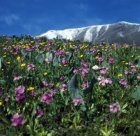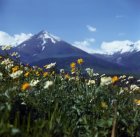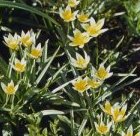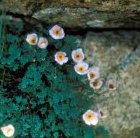 |
QUICK SEARCH
MO PROJECTS:
Africa
Asia/Pacific
Mesoamerica
North America
South America
General Taxonomy
Photo Essays
Training in Latin
America
MO RESEARCH:
Wm. L. Brown Center
Bryology
GIS
Graduate Studies
Research Experiences
for Undergraduates
Imaging Lab
Library
MBG Press
Publications
Climate Change
Catalog Fossil Plants
MO DATABASES:
W³MOST
Image Index
Rare Books
Angiosperm
Phylogeny
Res Botanica
All Databases
INFORMATION:
What's New?
People at MO
Visitor's Guide
Herbarium
Jobs & Fellowships
Symposium
Research Links
Site Map
Search
ORNAMENTAL PLANTS IN THEIR NATURAL HABITATSB. Kyrgizstan
An excursion to Ala-Archa, a nature park and reserve, takes one across the different vegetation zones of the Kyrgyzstan mountains. The road runs along the banks of the narrow river Ala-Archa. Dense shrubs of the sea buckthorn, Hippophae rhamnoides along with Rosa beggeriana with white flowers to 4 cm (1.5") diameters abundantly produced in dense, many-flowered clusters and R. platyacantha, with solitary yellow flowers to 5 cm (2") diameters are found in the lower reaches of the gorge
Spring in the subalpine and alpine meadows may start as late as May, and some of the first plants to flower are yellow Adonis chrysocyathus and the pale lilac globeflower Hegemone lilacina. Many botanists treat the latter as a distinct genus, while others maintain it as
Located at 1,000 m (3,288 ft), also in Kyrgyzstan, Lake Issyk-Kulí is flanked by two Tien Shan ranges (the Terskey Alatau and Zailiyskiy Alatau). These mountain tops are covered by permanent ice caps. The road from Bishkek runs along the river Chu, the banks of which are overgrown by thickets of willow Salix wilhelmsiana, and Russian olive Eleagnus angustifolia. Tall shrubs of Abelia corymbosa, a sacred plant of aboriginal peoples and very rare today, grow on mountain slopes and in protected hollows some 20-30 km (10-20 mi) west of Bishkek. Ephedra eguisetina, a well-known medicinal shrub, grows on stony mountain sites. Lake Issyk-Kulí is saline and surrounded by alkaline soil, called by Russian word solonchak, which supports widespread species of the genera Artemisia, Kochia and Salsola. Lacy crowns of the showy shrubs Myricaria germanica and Tamarix ramosissima (both of which are salt-resistant) catch the eye at higher elevations. Vast stretches of mountain slopes are occupied by spruce forests (Picea schrenkiana) along with junipers Juniperus semiglobosa and J. sabina. A monument to Nicolai M. Przhewalskiy, the famous Russian scientist and explorer at the end of 19th century, is seen near Przhevalísk (now Bajungol), a town not far from Issyk-Kulí.
The Tien Shan is dominated by spruce forests of Picea schrenkiana. Intriguing plants of the area include the white-flowered vine Atragene sibirica [=Clematis alpina subsp. sibirica], the shrub rose Rosa albertii, a herbaceous perennial Alfredia nivea, which produces beautiful rosettes of coriaceous cleft leaves, as well as a monkshood Aconitum leucostomum. Alpine meadows are dominated by a remarkable fleabane Erigeron aurantiacus producing red to orange flower heads, color not very often within fleabane, a yellow-orange poppy (Papaver tianschanicum), bright yellow globeflower Trollius dschungaricus and a pasque flower Pulsatilla campanella with nodding, violet flowers. At upper vegetation limits are found daisy-like Callianthemum alatavicum, Cerastium lithospermifolium and rockfoil Saxifraga oppositifolia, all of which are small plants particulary suitable for the rock garden. In rocky places the unusual Paraquilegia anemonoides [=P. grandiflora] forms close, dense tufts from a thick rootstock with stout bristles, and produces very attractive large, solitary, pale pink or pale lilac flowers. |
||||
| ORNAMENTAL PLANTS FROM RUSSIA |
© 1995-2025 Missouri Botanical Garden, All Rights Reserved
4344 Shaw Blvd.
St. Louis, MO 63110
(314) 577-5100
Technical Support



